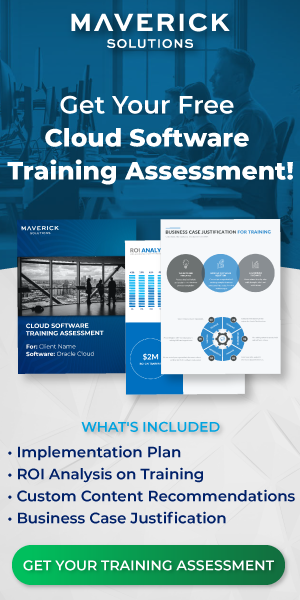In the world of IT (information technology), where change and innovation occur pretty much every other second, it is no surprise that we are constantly playing catch up. It feels like yesterday we were writing on stone tablets, and tomorrow we’ll be unveiling the new flying car.
While all this advancement in technology is wonderful in many ways, it is no small task to stay up to date when it comes to the technology you use every day. Let’s talk about why training is so important in this landscape, the impact it can have on you and your business, and what the best training on enterprise Cloud software looks like.
What is training?
At its core, training is the acquisition of knowledge, skills, and/or competencies, sometimes with the help of an instructor, for the purpose of achieving an end result. That end result can be anything from completing a marathon to becoming proficient with the tools and technology necessary to do your job. Let’s use my friend, Bob, as an example.
Bob shows up to his job every day in hopes of making the world a slightly better place. Bob understands his job role, the tasks he must perform, and the tools he is provided with to execute these tasks. Bob’s tools consist of several types of business software to help him complete his tasks in a timely fashion.
One day, Bob’s company, Slightly Better Place Inc., decides to switch over to an Enterprise Business Solution, because it will be more efficient to run their many processes out of a single software platform rather than multiple different platforms. Now Bob is handed a brand-new set of tools, but he has only a limited understanding of how to use them. Bob is now lacking the knowledge, skills, and competencies required of him to operate these tools and help make the world a slightly better place.
Training is what allows Bob to receive the required knowledge, skills, and competencies for using these new tools effectively and continue to execute his daily tasks. Incorporating new and efficient technology is only half the battle for a business. A robust training solution should also be considered a necessary component.
In other words, training is a means to an end.
Why train at all?
We don’t train simply for the sake of training. As mentioned, we train specifically to achieve a certain outcome or result. So, what kind of results are we looking for?
Effective training has been known to:
- Enhance worker efficiency/productivity
- Improve overall employee satisfaction/happiness
- Increase worker independence
- Reduce wasted resources
- Reduce stress
- Reduce employee turnover
It isn’t difficult to understand why Bob is much happier, more productive, and experiences greater satisfaction and independence with his job after receiving the appropriate training for his new set of tools.
On the flip side, since his training, he is significantly less stressed about wasting time trying to figure out these new tools and decided not to submit his newly polished resume and cover letter to that sketchy job hunt website. Bob can now go back to focusing on making the world a slightly better place.
What training solution options do I have?
Up to this point, you might be thinking “I already know all this. I know what training is and I know why it is valuable for my business. What I really want to know is what training solution options are available to me?”
I’m so glad you asked.
For the longest time, the most common form of instruction was known as Instructor-Led Training (ILT).

In the tech space, a company would develop software that businesses could use to streamline their tasks and increase efficiency. This is a great thing, right? Yes, but now that company would have to pay professionals to come out and physically install and set up that software on the company’s internal system.
In addition, the company would also pay for instructors to come out and teach all their employees how to use this new software. This was all worth it, however, because the gains to be had through increased efficiency outweighed the short-term difficulty and costs of adopting this new technology.
What about SaaS?
Then, on that fateful day in 1999, Salesforce would change the world by offering the first Software as a Service (Saas).
SaaS introduced the concept of providing access to software a company could use, but without having to host that software locally. Because of SaaS, a monthly (or yearly) subscription and a connection to the internet were all you needed to have these powerful tools at your fingertips, maintenance free!
Of course, early on, it was quite slow and really only thought to be for small companies or startups. However, SaaS has grown to become commonplace even for enterprise-level businesses and can meet many needs without the usual hassle of on-premises solutions, and often for a better price.
With the incredible innovation of SaaS, you don’t even have to update the software, it is all inclusive! That means that yearly, bi-yearly, or even quarterly, your software will automatically update to the latest changes and innovations to keep your company on the cutting edge of technological advances.
But what does this all have to do with training?
Is ILT effective for learning SaaS?
This is where things get a little muddy. SaaS comes along and revolutionizes the business industry and how we all think about our business tools, but training has remained relatively the same.
So, how does ILT prepare employees for using software that might be completely different in just one year from now? Even though everybody loves sitting in the conference room for a week of training, is it really feasible for a company to continue to pay for instructors to come out once a quarter to do refresher classes every time there is a software update?


It would be quite cost-prohibitive to maintain a regular rhythm of ILT, but the alternative is to leave employees uneducated regarding their work tools every time the software undergoes updates. Do you sacrifice cost or efficiency? What is a company to do?
What is TaaS?
Enter Training as a Service (TaaS). TaaS is very similar to SaaS. TaaS gives you subscription-based access to training content that is hosted by the training company. And just like with SaaS, TaaS provides freshly updated content with every software update.
Here at Maverick Solutions, our training material includes multiple types of content such as topics written about the tools you use, simulations that allow you to explore what the software you have will look and feel like without having to worry about breaking anything, and even in-app guidance to help users navigate and use the live system.
All of this training material stays constantly up to date and in line with each software update, so employees always have a resource for how to use the company’s business systems most effectively. In the same way that training should be an appropriate response to adopting new technology for your business, in a more specific fashion, TaaS (as opposed to ILT) is the appropriate response to adopting SaaS.
Why is this?
Let’s think about ILT and TaaS as static and dynamic, respectively. When dealing with SaaS, ILT is a static “one and done” style of training. That is great for getting started, but ultimately lacks long-term support and isn’t realistic to maintain with regular updates. However, TaaS is dynamic, just like SaaS, because it is constantly being maintained and updated on your behalf, without you having to lift a finger!
So now we get to the million-dollar question…
What does the best training on enterprise cloud software look like for me?
Honestly, it depends.
I know it isn’t a popular answer, but there really isn’t a “one size fits every business in the world” solution. However, I think we can safely break this down into two categories of thought. Does your company use an on-premises enterprise software solution or SaaS?
If your company recently adopted, or is planning to implement, an on-premises business software solution, ILT is probably going to be the best choice for you.
If your company is making the transition over to SaaS, I would heavily recommend considering TaaS. Not only does TaaS provide many of the same benefits as SaaS, but it means having a long-term training partner that will be there to support your organization, not just at implementation and go-live, but for years to come as you continue to receive guidance on how to navigate this ever-changing landscape.
At the end of the day, I think we can agree that some training is better than no training. But do your due diligence, kick the tires a bit, make sure that the training you are considering is going to be a good fit for you and your company.
Maverick Solutions has built training specifically for Oracle Cloud software in mind. ENGAGE Learn, Maverick Solution’s Training as a Service offering, is updated quarterly. It is fully customizable, comprehensive, and available 34/7/365. We work with your team to build learning paths, customize training documentation to match your company’s unique business processes, and customize training to look and function like your instance of Oracle Cloud.
And because training is not always the answer to every user’s software issues, your teams can also use the in-app features of ENGAGE Live. Our in-application support tool can guide users step-by-step through complex business processes in the live application.
ENGAGE Learn and Live help companies see the following:
- Decrease in IT support tickets.
- Increase in user adoption.
- Increase in user proficiency.
- Increase in ROI on Oracle Cloud investment.
We are happy to talk with you to see if our training would be a good fit for you. We offer demos and examples of how our training can benefit your organization. Reach out to us today to learn more!



